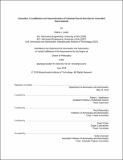| dc.contributor.author | Lewis, Diana J.
(Diana Jean) | en_US |
| dc.contributor.other | Massachusetts Institute of Technology. Department of Aeronautics and Astronautics. | en_US |
| dc.date.accessioned | 2020-10-18T21:23:06Z | |
| dc.date.available | 2020-10-18T21:23:06Z | |
| dc.date.copyright | 2020 | en_US |
| dc.date.issued | 2020 | en_US |
| dc.identifier.uri | https://hdl.handle.net/1721.1/128053 | en_US |
| dc.description | This electronic version was submitted by the student author. The certified thesis is available in the Institute Archives and Special Collections. | en_US |
| dc.description | Thesis: Ph. D., Massachusetts Institute of Technology, Department of Aeronautics and Astronautics, 2020 | en_US |
| dc.description | Cataloged from the PDF of thesis. | en_US |
| dc.description | Includes bibliographical references (pages 163-169). | en_US |
| dc.description.abstract | The directed assembly of nanoscale components has the potential to generate novel macroscopic materials with specific hierarchically ordered structures and programmable physical and chemical properties. DNA is a particularly promising material to direct nanomaterial assembly, as its sequence-specific complementary binding allows DNA to be used to precisely tailor interactions between a multitude of different nanoscale elements, allowing formation of complex nanoscale structures without top-down instruction. While multiple DNA-based materials assembly methods have been developed, the mechanical properties of many of these systems are unknown due to limitations in both the preparation of materials suitable for mechanical testing and difficulties in measuring the behavior of these soft materials under applied force. The modulus of one particular architecture - DNA-NP superlattices - is studied here by first examining methods to create thin films of DNA-NPs that can be accurately probed using nanoscale mechanical testing techniques, then using AFM nanoindentation of various superlattice designs to correlate DNA-NP lattice structure to mechanical behavior. A layer-by-layer deposition strategy was first examined in order to understand how deposition conditions affect the packing density and surface roughness of thin films of DNA-NPs as a function of deposition time, bulk system temperature, and solution ionic strength. Subsequent experiments used a slow-cooling method to generate single crystal superlattice architectures, where the size and shape of the substrate-bound crystals could be tailored by tuning the relative strength of the interactions between the substrate and DNA-NPs, and could be described by the Winterbottom construction. Additionally, FCC single crystal structures were demonstrated, which have not been previously shown in literature. Using the substrate-bound crystals, the dependence of the modulus on DNA length, nanoparticle size, and density of DNA strands was determined, which allowed for the establishment of design rules that will ultimately enable control over the mechanical properties of future DNA-based nanoparticle structures. | en_US |
| dc.description.statementofresponsibility | by Diana J. Lewis. | en_US |
| dc.format.extent | 169 pages | en_US |
| dc.language.iso | eng | en_US |
| dc.publisher | Massachusetts Institute of Technology | en_US |
| dc.rights | MIT theses may be protected by copyright. Please reuse MIT thesis content according to the MIT Libraries Permissions Policy, which is available through the URL provided. | en_US |
| dc.rights.uri | http://dspace.mit.edu/handle/1721.1/7582 | en_US |
| dc.subject | Aeronautics and Astronautics. | en_US |
| dc.title | Deposition, crystallization and nanoindentation of substrate-bound biomolecule-assembled nanomaterials | en_US |
| dc.type | Thesis | en_US |
| dc.description.degree | Ph. D. | en_US |
| dc.contributor.department | Massachusetts Institute of Technology. Department of Aeronautics and Astronautics | en_US |
| dc.identifier.oclc | 1199059122 | en_US |
| dc.description.collection | Ph. D. Massachusetts Institute of Technology, Department of Aeronautics and Astronautics | en_US |
| dspace.imported | 2023-03-08T20:25:33Z | en_US |
